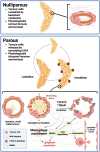Status of breast cancer detection in young women and potential of liquid biopsy
- PMID: 38835377
- PMCID: PMC11148378
- DOI: 10.3389/fonc.2024.1398196
Status of breast cancer detection in young women and potential of liquid biopsy
Abstract
Young onset breast cancer (YOBC) is an increasing demographic with unique biology, limited screening, and poor outcomes. Further, women with postpartum breast cancers (PPBCs), cancers occurring up to 10 years after childbirth, have worse outcomes than other young breast cancer patients matched for tumor stage and subtype. Early-stage detection of YOBC is critical for improving outcomes. However, most young women (under 45) do not meet current age guidelines for routine mammographic screening and are thus an underserved population. Other challenges to early detection in this population include reduced performance of standard of care mammography and reduced awareness. Women often face significant barriers in accessing health care during the postpartum period and disadvantaged communities face compounding barriers due to systemic health care inequities. Blood tests and liquid biopsies targeting early detection may provide an attractive option to help address these challenges. Test development in this area includes understanding of the unique biology involved in YOBC and in particular PPBCs that tend to be more aggressive and deadly. In this review, we will present the status of breast cancer screening and detection in young women, provide a summary of some unique biological features of YOBC, and discuss the potential for blood tests and liquid biopsy platforms to address current shortcomings in timely, equitable detection.
Keywords: breast cancer; early detection; involution; liquid biopsy; molecular diagnostics; postpartum; young women.
Copyright © 2024 Stibbards-Lyle, Malinovska, Badawy, Schedin and Rinker.
Conflict of interest statement
Author KR is a co-founder, director, and shareholder of the company Syantra, Inc. The remaining authors declare that the research was conducted in the absence of any commercial or financial relationships that could be construed as a potential conflict of interest.
Figures



Similar articles
-
Responding to the challenges of breast cancer in egypt and other arab countries.J Egypt Natl Canc Inst. 2008 Dec;20(4):309-12. J Egypt Natl Canc Inst. 2008. PMID: 20571588
-
Lifetime alcohol consumption patterns and young-onset breast cancer by subtype among Non-Hispanic Black and White women in the Young Women's Health History Study.Cancer Causes Control. 2024 Feb;35(2):377-391. doi: 10.1007/s10552-023-01801-z. Epub 2023 Oct 3. Cancer Causes Control. 2024. PMID: 37787924
-
Screening mammography for women aged 40 to 49 years at average risk for breast cancer: an evidence-based analysis.Ont Health Technol Assess Ser. 2007;7(1):1-32. Epub 2007 Jan 1. Ont Health Technol Assess Ser. 2007. PMID: 23074501 Free PMC article.
-
Recommendations for the Equitable and Widespread Implementation of Liquid Biopsy for Cancer Care.JCO Precis Oncol. 2024 Jan;8:e2300382. doi: 10.1200/PO.23.00382. JCO Precis Oncol. 2024. PMID: 38166232 Free PMC article. Review.
-
Overview of resistance to systemic therapy in patients with breast cancer.Adv Exp Med Biol. 2007;608:1-22. doi: 10.1007/978-0-387-74039-3_1. Adv Exp Med Biol. 2007. PMID: 17993229 Review.
Cited by
-
The impact of liquid biopsy in breast cancer: Redefining the landscape of non-invasive precision oncology.J Liq Biopsy. 2025 May 21;8:100299. doi: 10.1016/j.jlb.2025.100299. eCollection 2025 Jun. J Liq Biopsy. 2025. PMID: 40521566 Free PMC article. Review.
-
Factors associated with breast cancer detection method in California women: an analysis of California Health Interview Survey data.Breast Cancer Res Treat. 2025 Feb;210(1):37-44. doi: 10.1007/s10549-024-07534-0. Epub 2024 Nov 16. Breast Cancer Res Treat. 2025. PMID: 39549160
References
-
- Bouferraa Y, Haibe Y, Chedid A, Jabra E, Charafeddine M, Temraz S, et al. . The impact of young age (< 40 years) on the outcome of a cohort of patients with primary non-metastatic breast cancer: analysis of 10-year survival of a prospective study. BMC Cancer. (2022) 22:27. doi: 10.1186/s12885-021-09100-z - DOI - PMC - PubMed
Publication types
LinkOut - more resources
Full Text Sources

